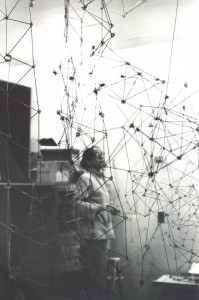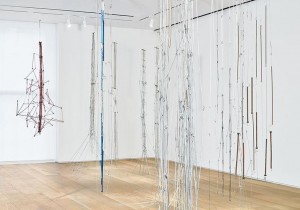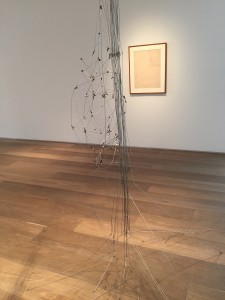

Works of Gego’s Reticulárea Series (1969-82)–sculptures in which slender lengths of wire are used to create space-enclosing networks of lines in undefined shapes–have increasingly appeared in museum collections and art fairs over the course of the past decade. Yet this German-born, Venezuelan artist, who died in 1994, remains underknown by North American audiences. A small survey of her work at the Drawing Center in 2007 attracted some attention, while a show at the Americas Society in 2012 was all but ignored. The tightly-curated, museum quality exhibition Gego: Autobiography of a Line, currently on view at the Dominique Lévy Gallery in New York, may finally do the trick in establishing her reputation. The show is timely, coming at a moment when abstraction is prevalent and when the hybrid, difficult-to-classify nature of her artistic production, which references the work of a host of previous artists while remaining uniquely her own, is of particular currency. Gego: Autobiography of a Line brings a wide scope of the artist’s achievements in sculpture to light, affirming that in employing wire as her primary material over the course of several decades, she explored a multitude of ways in which line could occupy and define space. The exhibition revealed that although Gego’s work is generally described as dispassionate and unequivocally abstract, it often carries emotional force and alludes to real world appearances.

Born to a Jewish family in Hamburg in 1912, Gego (Gertrud Goldschmidt) was trained as an architect in Stuttgart before fleeing Nazi Germany for Venezuela in 1939. Her background in architecture continued to serve her when she turned to sculpture in the early fifties, her focus being upon the distribution of lines in space and the spaces in between.

The architectural dimension of Gego’s art was well demonstrated in the exhibition in the reunification of works from the artist’s Chorros installation, which debuted at the Betty Parsons Gallery in 1971. The Chorros are towering sculptures made of interconnected wires that extend from the ceiling and cascade down to the floor, most of them emphatically vertical in orientation (Chorro means waterfall); they interrupt the space of the gallery so that the viewer has to wend his or her way among them. While fundamentally abstract, the wires in many of the Chorros splay in graceful fashion as they extend onto the floor, evoking a spray of water, but also a person’s dancelike step. The totemic quality of the sculptures is accentuated in Chorro No.9, in which an artful distribution of wires in space suggests the enlarged belly and breasts of a pregnant woman.

Chorro No.3 (1970) is transparent, largely immaterial and crystalline in shape, yet paradoxically calls to mind Louise Bourgeois’ volumetric, biomorphic and similarly suspended painted bronze Fee Couturiere (1969; see below). While Gego’s labor-intensive art has not been assigned to any “ism,” some of her work seems compatible with that of Bourgeois, Eva Hesse and others associated with Process Art–an art of hand-worked, irregular forms often subject to the force of gravity–that reacted against the industrial manufacture and strict geometry of the Minimal Art that dominated the New York art scene in the early and mid-sixties, a period when Gego was making frequent visits to New York. An artist to whose work Gego’s begs comparison is the “fiber sculptor” Ruth Asawa, the Japanese-American artist based in San Francisco who began crocheting wire into hanging mobiles in rounded, biomorphic shapes beginning in the mid-1950s. One wonders whether Gego and Asawa might have met, as both worked at Tamarind Lithographic Workshop in Los Angeles in the middle sixties. Finally, it would be remiss not to point out that Gego’s predilection for drawing in space with line reaches back in art history to find precedents in Picasso’s welded steel constructions of 1927-31 and Alexander Calder’s wire sculptures begun in the late twenties.

Although Gego’s art provokes artistic references (Robert Storr, when confronted with her work in 2003, suggested a multitude of these), Gego was quite literally on her own tangent. Consider, for example, the Debujo sin papel (Drawing without paper) Series of the late 1980s in which the artist used wire together with various other elements to create works that are planar in structure and pictorial in nature, most of them self-enclosed by square or rectangular frames. In Debujo sin papel 86/15 (1986), for example, the frame consists of a red-painted metal bar that falls just short of describing a rectangle, its form completed by an undulating strip of metal near the top of the left side and by a straight metal bar below. Dark nylon threads extend the length of the piece, the whole suggesting a delicate stringed instrument. At the work’s bottom edge, knotted threads hang loose to be stirred by air currents, adding a kinetic element. The fact that the piece is suspended in front of the wall and throws shadows upon it, which shift as the viewer moves, further activates the work and its linear rhythms.

In contrast to the lyricism of Debujo de paper 86/15 are other reliefs of the same series (among them Dibujo sin papel 88/35, 1988) in which the wires are broken, jagged, coiled and barbed, the works as a whole appearing electrified and expressive of confusion and pain. I am uncertain whether they were executed in response to the political upheavals in Caracas at the time or to something unsettling in the artist’s life. However, as is hinted at by the exhibition’s title–Gego: Autobiography of a Line, which derives from that of her first book of etchings of 1965–it seems apparent that Gego’s wire occasionally extended into the world directly from her heart.
